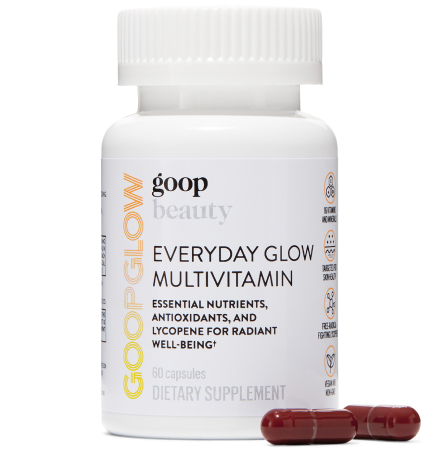
Photo courtesy of Heather Hazzan/The Licensing Project

Supported by Science
Should I Take an Iron Supplement? Identifying Symptoms of Low Iron in Women
Should I Take an Iron Supplement? Identifying Symptoms of Low Iron in Women
By Gerda Endemann, PhD
May 5, 2022
Many women are not consuming the iron they need for healthy energy, stamina, focus, and glowing skin. This is not an overblown claim. It comes from the US Department of Health and Human Services, which is careful not to sound alarms about the American diet. If you answer yes to any of the following questions, you may wish to talk to your doctor about your iron status: Do you eat very little meat? Do you have heavy periods? Do you often feel tired and worn out?
Almost 10 percent of nonpregnant women and 25 percent of pregnant women in the US are iron deficient, according to a National Health and Nutrition Examination Survey. According to other research, up to 18 percent of healthy women may be low in iron. Because of this, it’s surprising that more women aren’t taking iron supplements. Multiple clinical studies have shown that when people who are iron deficient take iron supplements, their iron status improves, and they report being less fatigued.
-
Kudos to the product development team at goop for including 100 percent of the Daily Value of iron—in a gentle, easy-to-absorb form—in a fantastic new multivitamin supplement, the GOOPGLOW Everyday Glow Multivitamin. The “glow” in the product name came from the research-backed skin benefits of its lycopene-rich tomato extract, but equally important is the vibrant cheek color that comes from a healthy iron status.*
-
goop Beauty
GOOPGLOW EVERYDAY
GLOW MULTIVITAMIN
goop, $60/$55 with subscriptionSHOP NOW
What Are Symptoms of Low Iron Levels?
Fatigue, Low Stamina, Low Energy, and Difficulty Concentrating
When iron levels are low, you may feel weak, tired, and like you have brain fog, and this can be true even if levels aren’t low enough for you to be diagnosed with anemia. Iron is crucial for the mitochondria—the energy-producing structures in cells—to function. And this affects both physical and mental energy.
We talk a lot about breathing at goop, and the calming power of deep belly breathing. But breathing wouldn’t accomplish much without red blood cells (RBC) to deliver oxygen from the lungs to the rest of the body. And inside RBC it’s the iron in the red hemoglobin molecules that carries oxygen.
A fire needs oxygen to burn, and it’s the same for the tiny fireplaces in our cells, the mitochondria, that burn fuels and produce heat and energy. When RBC have enough iron, they can provide body tissues with the oxygen they need. When iron or other nutrients—folate, B12, and copper—needed for healthy RBC are low, this affects physical stamina and strength, as well as mental focus and clarity.
Pale Skin, Hair Loss, and Brittle Nails
When levels of hemoglobin and RBC are low, mucous membranes of the eyes and mouth look pale, and light-colored skin loses its rosy glow. Hair and nails are affected also, with low iron being a common cause of hair loss. It’s also linked to spoon-shaped nails and ridges in nails.
Restless Legs Syndrome
It’s complicated, but iron deficiency appears to contribute to restless legs.
What Are Risk Factors for Iron Deficiency?
Menstruation
Iron is lost with blood, and that happens with childbirth and monthly with menstruation. We may take heavy periods for granted, but needing to change your tampon every hour means that it’s time to consult with your doctor.
Pregnancy and Childbirth
In addition to blood loss while giving birth, a lot of iron is used in the womb to grow a baby.
Growing
Iron is needed to form new tissues. This is a big deal for toddlers, adolescents, and athletes.
Being Vegetarian
The iron in vegetables is absorbed only about one fifth as well as the iron in meat.
Celiac Disease
Many nutrients are not well absorbed in celiac disease because of damage to the intestine and chronic diarrhea. There’s more information about celiac disease in our goop PhD article.
How To Determine Your Iron Status
Ask your doctor for a ferritin blood test—a sensitive measure of iron status—in addition to the standard hemoglobin test. You can have “normal” hemoglobin levels and still have suboptimal iron status. For historical reasons that may not be valid, it’s considered acceptable for women to have lower hemoglobin levels than men. A hemoglobin level of 12 would flag a man for treatment, while a woman may be told that she is fine, that she doesn’t need to worry, and that low iron is not the cause of her fatigue.
How Can I Support Healthy Iron Levels?
Maximize Absorption from Food
The perfect iron-depleting storm combines heavy periods, being vegetarian, and drinking tea with meals. Vegetarians are more likely to be low in iron than meat eaters because we absorb a much greater portion of the iron in meats and seafood than in plant foods. And dairy products don’t contain much iron. We don’t know why, but even a little meat mixed with vegetables increases the iron you get from the veggies. Beans and green vegetables are good vegetarian sources of iron.
If you like to drink tea and coffee with meals, be aware that they inhibit iron absorption. Instead, have some orange juice or other fruits and veggies that contain vitamin C, which promotes absorption.
Take an Iron Supplement
When I ask people who seem tired and pale whether they’ve tried iron supplements, what I’m frequently told is that they have tried but stopped because the pills upset their stomach. That’s why goop’s formulators included a gentle form of iron called ferrous bisglycinate chelate (Ferrochel®) in the Everyday Glow Multivitamin. This form is much less likely to cause gastrointestinal discomfort than the ferrous fumarate and ferrous sulfate commonly found in supplements, as has been demonstrated in multiple clinical trials. It is also absorbed more completely, when compared with other forms of iron.*
Everyday Glow also contains vitamin C to support iron absorption.*
How Long Will I Need to Take Iron For?
Be patient and maintain a consistently healthy iron intake, because optimizing iron status is not a quick fix. It will take at least a week or two, and up to several months, to see progress.
Related Reading
Our Dietitian Answers Your Q’s on the Everyday Glow Multivitamin
Ask Gerda: Am I Just Peeing Out My Supplements?
Ask Gerda: What’s Your Nutritional Advice for Vegans and Vegetarians?
Gerda Endemann holds a BS in nutrition from the University of California at Berkeley and a PhD in nutritional biochemistry from the Massachusetts Institute of Technology. Her professional experience is wide-ranging; she’s conducted scientific research, focused on nutrition education, and worked in the dietary supplement industry. Endemann has conducted basic research on heart disease, fat metabolism, and nutrition in academic laboratories and in biotech, and she has served as an adjunct faculty member at Stanford University.
This article is for informational purposes only. It is not, nor is it intended to be, a substitute for professional medical advice, diagnosis, or treatment and should never be relied upon for specific medical advice. To the extent that this article features the advice of physicians or medical practitioners, the views expressed are the views of the cited expert and do not necessarily represent the views of goop.
*These statements have not been evaluated by the Food and Drug Administration. These products are not intended to diagnose, treat, cure, or prevent any disease.
Ferrochel® is a registered trademark of Balchem Corporation or its subsidiaries.


